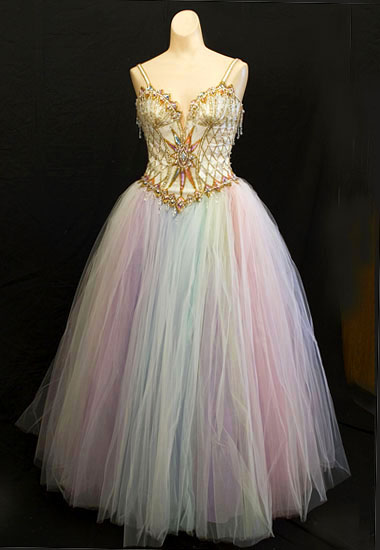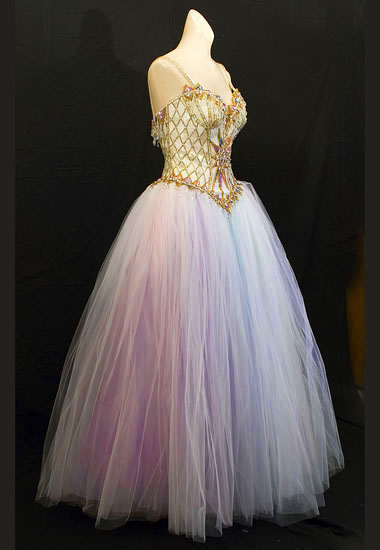

A Bob Mackie creation, circa 1991.
I think this is a really beautiful dress,
and an adult version of the Disney
Princess dresses made for children.
I got the pictures from this website.
Before I begin with the topic at hand, I would like to say that, when you have two preschool children, writing a blog entry becomes an act of will.
Now, onto “The romance of romance” or, more precisely, “The strange appeal of the Disney Princesses.” Lily is very much a girly-girl. She grew into this personality all by herself; Matt and I merely gave her the freedom to explore her own tastes. And, being such a girly-girl, she was early-on attracted to clothes. In fact, I quit dressing her before she turned two-years-old because the arguments weren’t worth the trouble. She insisted on picking her own clothes.
As she has become more explorative with clothes, she has been attracted to the Disney Princess line of dresses, and, from there, to the Disney Princesses in general. And, here’s my dirty little secret: I like the Disney Princess line of merchandising as well. I don’t like the ubiquitous quality of the line — like all things that do financially well in corporate America, Disney milks that cash cow for every little penny it can possibly get.
Since the Princesses have invaded my house, partially due to Lily and partially due to myself, I have been thinking about their appeal to the feminine. And I think it comes down to romance. And I don’t mean romance as in “falling in love.” Lily could care less about the princes; they are just a minor plot point as far as she is concerned. And I am already in love; my prince charming exists in my life on a daily basis.
I mean romance as in beautiful dresses, climbing roses, the smell of lilies, and idealic pastoral afternoons. I think the Disney Princesses are a representation of this; they are always in their flowing dresses and surrounded by flowers. (Their Prince Charmings are very rarely pictured with them.)  For American culture, they have evolved into the archetype of the romantic feminine within us — the part of us that longs to live an idealic romantic life full of flowers and kitchen gardens in the French countryside.
I looked up the term “archetype” to make sure I was using the word correctly, and dictionary.com said “the original pattern or model from which all things of the same kind are copied or on which they are based; a model or first form; prototype.” And I thought, “Well, something can’t really evolve into an archetype, can it?” But the sentence still settles really well with me. Culture evolves; archetypes evolve. And our children are looking to Ariel and Snow White, not Venus, to define the American romantic feminine. Which, truthfully, is a bit scary. As far as I know, none of the Disney princesses went to university. Maybe, just like our mothers did, we need to expose them to Gloria Steinem as well as Snow White.
Anyways, these are my humble thoughts on the strange appeal of the Disney Princesses to both young and old women. Since I’ve ferreted out their base note, I’m looking elsewhere for iconic images that conjure dreams of a romantic life. The Disney Princesses are a bit… well, packaged. They have the shiny coating and one-dimensional lack of depth that comes from corporate mass marketing.
… I do still like them though. 😉
ps. For another take on the Disney Princesses, you can read this article, titled “What’s Wrong with Cinderella?” by Peggy Orenstein and written for the NY Times.
pps. There is an excellent movie whose main character also dreams of a romantic life (romantic as I have defined it here, and not as in “falling in love”), titled “Kamikaze Girls.” It’s Japanese so it’s subtitled, but I can’t recommend this movie strongly enough. I really really enjoyed it.
No comments yet.
RSS feed for comments on this post. TrackBack URI